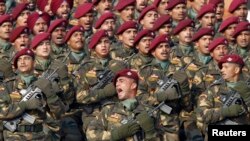Special forces commandos of the Indian army attacked two insurgent camps in the India-Myanmar border region, five days after the rebels killed 18 soldiers in an ambush in the northeast Indian state of Manipur, the army said.
An army spokesman in Delhi said the assaults were launched at two locations Tuesday, on two separate groups “along the Indo-Myanmar border,” inflicting “significant casualties” on the insurgents.
A junior minister in Prime Minister Narendra Modi’s Cabinet said later in a televised interview that the commandos struck inside Myanmar.
"The operation involved our special forces crossing the border and going deep into another country. There were two camps. Both camps were struck and were completely annihilated," said Minister of State for Information and Broadcasting Rajyavardhan Singh Rathore, a former army colonel. “Such [rebel] attacks [like the one in Manipur] will no more be tolerated. It was a historic and very brave decision by the prime minister to go in hot pursuit and annihilate the rebel camps. And, that’s exactly what was done… We crossed over to the Myanmar territory. We have good relations with them (Myanmar authorities) and we carried out the strike," he added.
Wise to Publicize?
Some anti-insurgency experts said politicians were wrong to publicize details of the June 9 cross-border operation.
“While the operational success in the case is to be appreciated, the political tom-toming and posturing is unfortunate. Significant operational details have also been revealed, which will help the rebels better prepare their future security,” Ajai Sahni, executive director of New Delhi-based Institute for Conflict Management, said to VOA.
“Such operations are best executed covertly and, where political imperatives require some disclosure, such revelations should be kept to the skeletal minimum – indicating only the broad location of the operation and the casualties inflicted,” he said.
Sahni added that media reports describing the June 9 operation as unprecedented in India’s military history were incorrect.
“There have been many cross-border ops in different theaters in the past, but these were executed covertly with fullest deniability maintained – which is the best template for such operations,” he said.
Media Detail Operation
According to a Press Trust of India (PTI) report, when the Indian army received intelligence that the rebels had returned to camps in Myanmar’s Sagaing division after the ambush, India’s home minister, defense minister, national security advisor, army chief and some other senior officials planned a “hot pursuit” operation to attack them across the border.
After the final clearance was given by Prime Minister Modi, necessary because the attack was to be launched in foreign territory, army authorities prepared the cross-border assault.
Once human reconnaissance missions, surveillance by air force UAVs and other technical intercepts confirmed the presence of the rebels in two specific camps in Myanmar - near the Indian states of Manipur and Nagaland - helicopters carried about 70 Indian special forces commandos across the border, Indian newspapers reported.
The commandos were dropped at strategic locations and approached the two rebel camps overland. PTI, quoting unnamed sources, reported the commandos killed 38 rebels and wounded seven others before being ferried back to Indian territory.
Rebel Presence
In Manipur, which borders Myanmar, there are dozens of ethnic groups and small guerrilla armies fighting New Delhi's rule. Some want to secede from India, while others seek greater autonomy.
Using rocket-propelled grenades, improvised explosive devices and other weapons, rebels ambushed an Indian army convoy in Manipur on June 4. The army lost 18 soldiers - the worst toll from such an insurgent attack in three decades.
Responsibility was claimed by the United National Liberation Front of West South East Asia (UNLFW) - a newly formed umbrella body of northeast Indian separatist groups comprising the National Socialist Council of Nagaland-Khaplang (NSCN-K), Kanglei Yawol Kanna Lup (KYKL), and Kangleipak Communist Party (KCP).
Myanmar and Rebels Reject Claims
While Indian minister Rathore said commandos moved “deep” inside Myanmar and killed the Indian insurgents in forested hideouts there, a senior Myanmar government official said the military operation did not cross over to his country’s territory.
"According to the information sent by Tatmadaw (Myanmar army) battalions on the ground, we have learned that the military operation was performed on the Indian side at India-Myanmar border," Zaw Htay, director of Myanmar's presidential office, said in a Facebook post Wednesday.
He added that on its soil, Myanmar would not allow any activity that was detrimental to the interest of a neighboring country.
In a Wednesday statement, the NSCN-K rejected news reports that Indian army commandos had killed 38 rebels in Myanmar.
The army’s claim of killing of NSCN-K or UNLFW rebels is “completely false,” and the group had not suffered any casualty on June 9, an unidentified NSCN-K leader said to the Nagaland Post newspaper.
The rebel leader challenged Indian army authorities to come out with the bodies of the rebels that the commandos claimed to have killed.






